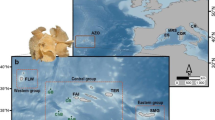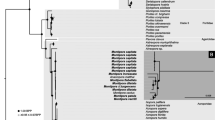Abstract
Recent genetic work on various coral genera has shown that morphological convergence between Atlantic and Pacific corals obscures evolutionary relationships and inferred levels of endemicity between the regions. Based on DNA sequences from nuclear and mitochondrial loci that provide higher resolution than those previously presented, this study shows that relationships within parts of the Atlantic coral fauna are also in need of substantial revision. The data presented here indicate that (1) the endemic Brazilian genus Mussismilia is a monophyletic clade, (2) Mussismilia is more closely related to the Caribbean Faviidae than Mussidae, the family in which it is currently placed, (3) the Brazilian endemic coral Favia leptophylla is much more closely related to Mussismilia than other species of Favia and has most likely been incorrectly placed in the genus Favia and (4) the other endemic Favia species found in Brazil, Favia gravida, is genetically distinct from Favia fragum, a Caribbean congener with which it is frequently synonymized. The nuclear data also suggest the possible presence of a cryptic species within Mussismilia, but additional sampling and morphological information is required to confirm this finding.



Similar content being viewed by others
References
Avise JC, Ankney CD, Nelson WS (1990) Mitochondrial gene trees and the evolutionary relationship of Mallard and Black ducks. Evolution 44:1109–1119
Bruno JF, Edmunds PJ (1997) Clonal variation for phenotypic plasticity in the coral Madracis mirabilis. Ecology 78:2177–2190
Budd AF (2000) Diversity and extinction in the Cenozoic history of Caribbean reefs. Coral Reefs 19:25–35
Budd AF, Klaus JS (2001) The origin and early evolution of the Montastraea “annularis” species complex (Anthozoa: Scleractinia). J Paleontol 75:527–545
Budd AF, Smith ND (2005) Diversification of a new Atlantic clade of scleractinian reef corals: insights from phylogenetic analysis of morphologic and molecular data. Paleontological Society Papers 11:103–128
Budd AF, Johnson KG, Potts DC (1994) Recognizing morphospecies in colonial reef corals.1. Landmark-based methods. Paleobiology 20:484–505
Budd AF, Foster CT, Dawson JP, Johnson KG (2001) The Neogene marine biota of Tropical America (“NMITA”) database: accounting for biodiversity in paleontology. J Paleontol 75:743–751
Castro CB, Pires DO (2001) Brazilian coral reefs: what we already know and what is still missing. Bull Mar Sci 69:357–371
Chen CA, Wallace CC, Wolstenholme J (2002) Analysis of the mitochondrial 12S rRNA gene supports a two-clade hypothesis of the evolutionary history of scleractinian corals. Mol Phylogenet Evol 23:137–149
Chevalier JP (1959) Quelques considerations sur la vie recifale au Miocène dans le bassin Méditerranéen. Bull Soc Geol Fr 4:369–374
Chevalier JP (1961) Recherche sur les madréporaires et les formations récifales Miocènes de la Méditerranée Occidentale. Mem Soc Geol Fr, Nouv Ser 40(93):1–562
Cuif JP, Lecointre G, Perri C, Tillier A, Tillier S (2003) Patterns of septal biomineralization in Scleractinia compared with their 28S rRNA phylogeny: a dual approach for a new taxonomic framework. Zool Scr 32:459–473
Foster AB (1979) Phenotypic plasticity in the reef corals Montastraea annularis (Ellis and Solander) and Siderastrea siderea (Ellis and Solander). J Exp Mar Biol Ecol 39:25–54
Foster AB (1980) Environmental variation in skeletal morphology within the Caribbean reef corals Montastraea annularis and Siderastrea siderea. Bull Mar Sci 30:678–709
Foster AB (1985) Variation within coral colonies and its importance for interpreting fossil species. J Paleontol 59:1359–1381
Fukami H, Budd AF, Levitan DR, Jara J, Kersanach R, Knowlton N (2004a) Geographic differences in species boundaries among members of the Montastraea annularis complex based on molecular and morphological markers. Evolution 58:324–337
Fukami H, Budd AF, Paulay G, Sole-Cava A, Chen CLA, Iwao K, Knowlton N (2004b) Conventional taxonomy obscures deep divergence between Pacific and Atlantic corals. Nature 427:832–835
Gittenberger A, Hoeksema BW (2006) Phenotypic plasticity revealed by molecular studies on reef corals of Fungia (Cycloseris) spp. (Scleractinia: Fungiidae) near river outlets. Contrib Zool 75:195–201
Gradstein F, Ogg J, Amith A (eds) (2004) A geologic time scale 2004. Cambridge University Press, Cambridge
Guindon S, Gascuel O (2003) A simple, fast, and accurate algorithm to estimate large phylogenies by maximum likelihood. Syst Biol 52:696–704
Hasegawa M, Kishino H, Yano TA (1985) Dating of the human ape splitting by a molecular clock of mitochondrial-DNA. J Mol Evol 22:160–174
Hellberg ME (2006) No variation and low synonymous substitution rates in coral mtDNA despite high nuclear variation. BMC Evol Biol 6:24. doi: 10.1186/1471-2148-6-24
Huelsenbeck JP, Ronquist F (2001) MRBAYES: Bayesian inference of phylogenetic trees. Bioinformatics 17:754–755
Johnson KG (1998) A phylogenetic test of accelerated turnover in Neogene Caribbean brain corals (Scleractinia: Faviidae). Paleontology 41:1247–1268
Kerr AM (2005) Molecular and morphological supertree of stony corals (Anthozoa: Scleractinia) using matrix representation parsimony. Biol Rev 80:543–558
Klaus JS, Budd AF, Heikoop JM, Fouke BW (2007) Environmental controls on corallite morphology in the reef coral Montastraea annularis. Bull Mar Sci 80:233–260
Knowlton N, Weil E, Weigt LA, Guzman HM (1992) Sibling species in Montastraea annularis, coral bleaching, and the coral climate record. Science 255:330–333
Laborel J (1969a) Les peuplements de madréporaires des côtes tropicales du Brésil. Ph.D. thesis, Université d’Abidjan, p 260
Laborel J (1969b) Madréporaires et hydrocoralliaires récifaux des côtes brésiliennes. Systématique, écologie, repartition verticale et géographique. Ann Inst Océanogr Paris 47:171–229
Laborel J (1974) West African reefs corals: an hypothesis on their origin. Proc 2nd Int Coral Reef Symp 1:425–443
Lasker HR (1981) Phenotypic variation in the coral Montastrea cavernosa and its effects on colony energetics. Biol Bull 160:292–302
Leão ZMAN (1996) The coral reefs of Bahia; morphology, distribution and the major environmental impacts. An Acad Bras Ciênc 68:439–452
Leão ZMAN, Ginsburg RN (1997) Living reefs surrounded by siliciclastics sediments: the Abrolhos coastal reefs, Bahia, Brazil. Proc 8th Int Coral Reef Symp 8:1767–1772
Leão ZMAN, Kikuchi RKP (2000) The Abrolhos reefs of Brazil. Ecol Stud 144:83–96
Lopez JV, Kersanach R, Rehner SA, Knowlton N (1999) Molecular determination of species boundaries in corals: genetic analysis of the Montastraea annularis complex using amplified fragment length polymorphisms and a microsatellite marker. Biol Bull 196:80–93
Maida M, Ferreira BP (1997) Coral reefs of Brazil, an overview. Proc 8th Int Coral Reef Symp 1:263–274
Medina M, Collins AG, Takaoka TL, Kuehl JV, Boore JL (2006) Naked corals: skeleton loss in Scleractinia. Proc Natl Acad Sci USA 103:9096–9100
Meeder JF (1987) The paleoecology, petrology and depositional model of the Pliocene Tamiami Formation, southwest Florida (with special reference to corals and reef evolution). Ph.D. thesis, University of Miami, p 748
Nylander JAA (2002) MrModeltest, v2.2. Program distributed by the author. Evolutionary Biology Center, Uppsala University, Uppsala
Posada D, Crandall KA (1998) MODELTEST: testing the model of DNA substitution. Bioinformatics 14:817–818
Rocha LA, Rosa IL (2001) Baseline assessment of reef fish assemblages of Parcel Manuel Luiz Marine State Park, Maranhão, north-east Brazil. J Fish Biol 58:985–998
Romano SL, Cairns SD (2000) Molecular phylogenetic hypotheses for the evolution of scleractinian corals. Bull Mar Sci 67:1043–1068
Romano SL, Palumbi SR (1996) Evolution of scleractinian corals inferred from molecular systematics. Science 271:640–642
Romano SL, Palumbi SR (1997) Molecular evolution of a portion of the mitochondrial 16S ribosomal gene region in scleractinian corals. J Mol Evol 45:397–411
Santos MG, Amaral FD, Hernández MIM, Knowlton N, Jara J (2004) Variação morfológica de Favia gravida Verrill, 1868 e Siderastrea stellata Verrill, 1868 (Cnidaria, Scleractinia): aspectos esqueléticos. Bol Mus Nac Rio J Zool 517:1–9
Saunders JB, Jung P, Biju-Duval B (1986) Neogene paleontology in the northern Dominican Republic. Part 1: field surveys, lithology environment and age. Bull Am Paleontol 89:1–79
Schellmann G, Radtke U, Scheffers A, Whelan F, Kelletat D (2004) ESR dating of corals reef terraces on Curaçao (Netherlands Antilles) with estimates of younger Pleistocene sea level elevations. J Coast Res 20:947–957
Shearer TL, van Oppen MJH, Romano SL, Worheide G (2002) Slow mitochondrial DNA sequence evolution in the Anthozoa (Cnidaria). Mol Ecol 11:2475–2487
Swofford DL (2002) PAUP*: phylogenetic analysis using parsimony (*and other methods), v4.0b10. Sinauer, Sunderland
Thompson JD, Gibson TJ, Plewniak F, Jeanmougin F, Higgins DG (1997) The CLUSTAL_X windows interface: flexible strategies for multiple sequence alignment aided by quality analysis tools. Nucleic Acids Res 25:4876–4882
Todd PA, Sanderson PG, Chou LM (2001) Morphological variation in the polyps of the scleractinian coral Favia speciosa (Dana) around Singapore. Hydrobiologia 444:227–235
van Oppen MJH, Willis BL, Miller DJ (1999) Atypically low rate of cytochrome b evolution in the scleractinian coral genus Acropora. Proc R Soc London, B 266:179–183
van Oppen MJH, McDonald BJ, Willis B, Miller DJ (2001) The evolutionary history of the coral genus Acropora (Scleractinia, Cnidaria) based on a mitochondrial and a nuclear marker: reticulation, incomplete lineage sorting, or morphological convergence? Mol Biol Evol 18:1315–1329
van Oppen MJH, Koolmees EM, Veron JEN (2004) Patterns of evolution in the scleractinian coral genus Montipora (Acroporidae). Mar Biol 144:9–18
Vaughan TW, Wells JW (1943) Revision of the suborders, families and genera of the Scleractinia. Spec Pap Geol Soc Am 44:1–345
Veron JEN, Stafford-Smith M (2000) Corals of the world. Australian Institute of Marine Science, Townsville
Watanabe T, Nishida M, Watanabe K, Wewengkang DS, Hidaka M (2005) Polymorphism in nucleotide sequence of mitochondrial intergenic region in scleractinian coral (Galaxea fascicularis). Mar Biotechnol 7:33–39
Weil E, Knowlton N (1994) A multi-character analysis of the Caribbean coral Montastraea annularis (Ellis and Solander, 1786) and its 2 sibling species, M. faveolata (Ellis and Solander, 1786) and M. franksi (Gregory, 1895). Bull Mar Sci 55:151–175
Wells JW (1956) Scleractinia. In: Moore RD (ed) Treatise on invertebrate paleontology, vol F. Geological Society of America and University of Kansas Press, New York, pp 328–444
Xia X, Xie Z (2001) DAMBE: software package for data analysis in molecular biology and evolution. J Hered 92:371–373
Acknowledgments
We would like to thank A. Solé-Cava for providing samples for this work and for the use of his laboratory facilities at the Universidade Federal do Rio de Janeiro, A.F. Budd for discussions regarding the morphological classification of Brazilian corals, C. Hurt and E. Gomez for assistance in the lab in Panamá, N. Le Dantec, D. Kline, C. Schroeder and J. Jara for their help with field collections in Panamá and two anonymous reviewers for their comments on the manuscript. We would like to thank the governments of Brasil, Panamá and São Tomé & Príncipe for their authorization to collect samples in their territories. This work was made possible by a grant from the National Science Foundation to NK (grant number 0344310) and by funding from Scripps Institution of Oceanography to RDN.
Author information
Authors and Affiliations
Corresponding author
Additional information
Communicated by Biology Editor M.J.H. van Oppen.
Rights and permissions
About this article
Cite this article
Nunes, F., Fukami, H., Vollmer, S.V. et al. Re-evaluation of the systematics of the endemic corals of Brazil by molecular data. Coral Reefs 27, 423–432 (2008). https://doi.org/10.1007/s00338-007-0349-0
Received:
Revised:
Accepted:
Published:
Issue Date:
DOI: https://doi.org/10.1007/s00338-007-0349-0




